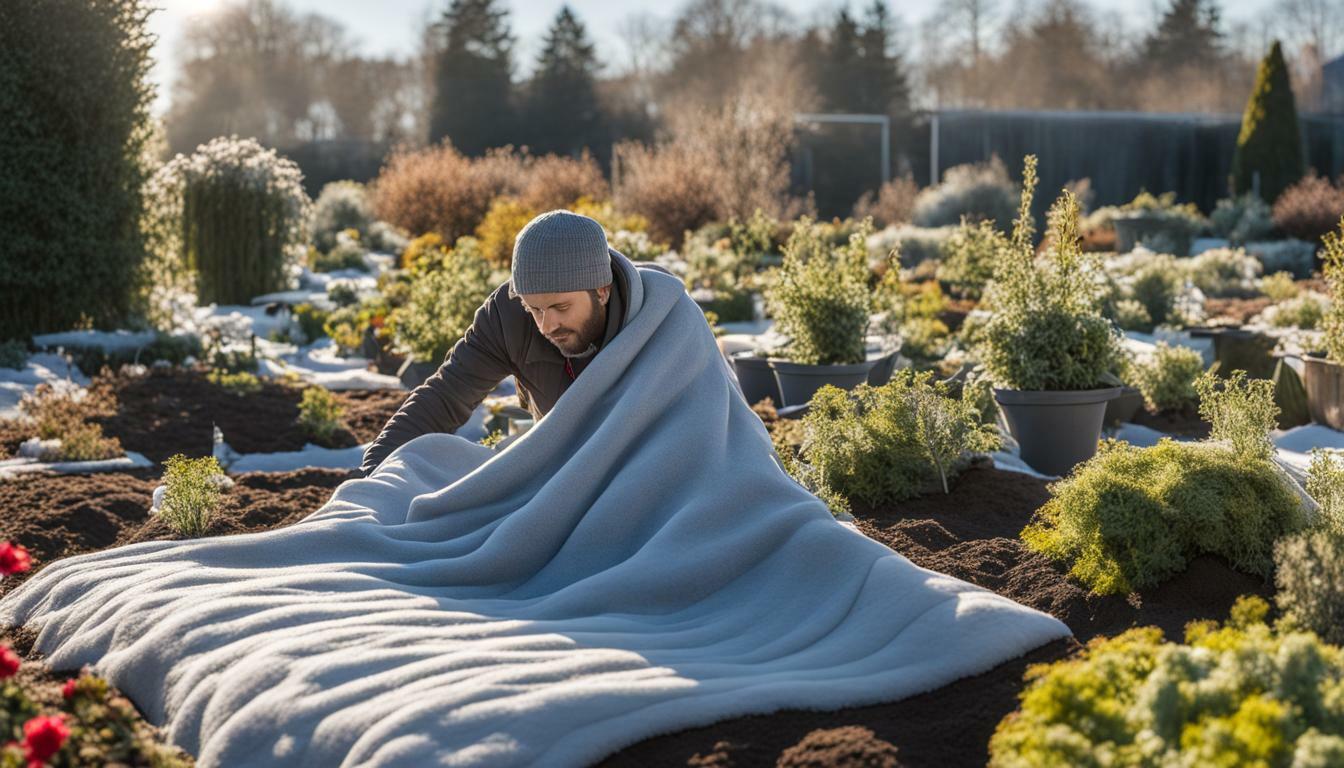Spring is a wonderful time for gardening and watching plants flourish, but it can also be a challenging time when late frosts occur. These unexpected freezing temperatures can damage or even kill young plants, leaving gardeners feeling frustrated and discouraged. However, with proper planning and preparation, you can protect your plants from late spring frosts and ensure a successful growing season.
Key Takeaways:
- Protecting plants from late spring frosts is essential for a successful growing season.
- Proactive measures can be taken to prevent late spring frost damage.
- Temperature fluctuations can also impact plant protection, so it’s important to monitor and adjust as necessary.
- Additional strategies, such as using coverings or growing cold-hardy plants, can also be effective in preventing late spring frost damage.
Understanding Late Spring Frosts and Their Impact on Plants
Spring is the time of year when plant growth begins to take off. However, late spring frosts can have a disastrous effect on plants that have already started to grow. A frost, which is defined as a temperature of 32°F (0°C) or below, can damage plant tissues, and sometimes even kill the plant outright. Late spring frosts often occur when the air temperature is warmer, but then suddenly drops due to a cold snap or other weather event.
It’s important to understand the impact of late spring frosts on plants, as well as to take steps to protect them. When a plant is exposed to frost, the water inside its cells freezes and expands, causing the cell walls to rupture. This can lead to visible damage such as wilting, browning, or blackening of leaves or stems. In some cases, the plant may sit dormant for a while before dying altogether.
A late spring frost can also affect the fruit or flowers of a plant. If the frost occurs during the blooming phase, the flowers may wither and fall off. If it occurs during the fruiting phase, the fruit may become discolored, soft, or deformed. In some cases, the fruit may not even develop at all.
Temperature Tolerance of Plants
It’s important to understand the temperature tolerance of the plants you have in your garden, so you know which ones are most vulnerable to late spring frosts. Some plants can tolerate cold temperatures better than others, so it’s important to choose plants that are appropriate for your area.
If you’re unsure about the temperature tolerance of a plant, you can look up information online or ask your local nursery or garden center for advice.
Protecting Your Plants from Late Spring Frosts
Now that you understand the impact of late spring frosts on plants and the temperature tolerance of the plants in your garden, you can take steps to protect them from damage. There are several strategies you can use to protect your plants:
- Cover your plants: Use blankets, tarps, or other materials to cover your plants before a frost. This will help to trap warm air around the plants, protecting them from the cold.
- Bring plants indoors: You can bring potted plants indoors or move them to a covered area to protect them from frost damage.
- Water your plants: Watering your plants before a frost can help to protect them, as moist soil retains heat better than dry soil.
- Mulch your plants: Mulching your plants can help to insulate them from the cold, keeping the soil and plant roots warmer.
By taking these proactive measures, you can help ensure that your plants survive any late spring frosts that may occur.
Proactive Measures to Prevent Late Spring Frost Damage
Protecting your plants from late spring frosts requires proactive measures. By taking a few steps in advance, you can help your plants survive a dip in temperature and prevent damage.
1. Cover your plants
One of the most effective ways to protect your plants from frost is to cover them with a cloth or blanket. The cover should be light enough to allow air circulation and prevent damage to the plants’ leaves, but thick enough to retain heat.
| Cover Materials | Effectiveness |
|---|---|
| Burlap | Good |
| Blanket | Better |
| Row cover | Best |
Note that if you use a plastic cover, it will trap heat during the day and may damage your plants. Remove the cover as soon as possible to allow air circulation and prevent overheating.
2. Water your plants before the frost
Watering your plants before a late spring frost can help protect them. Wet soil and leaves retain more heat than dry ones, which can help the plants survive a sudden drop in temperature. However, do not overwater your plants as this can cause other problems, such as root rot and mold growth.
3. Mulch your plants
Mulching your plants can help protect them from frost by retaining heat and moisture in the soil. A layer of organic mulch, such as straw, leaves, or wood chips, can also protect the roots of your plants from sudden temperature changes. Apply a layer of mulch about 2-3 inches thick around the base of your plants.
4. Move your plants indoors
If you have potted plants, you can move them indoors to protect them from frost. Place them in a warm, bright location away from cold drafts and heat sources. You can also group several plants together for added insulation.
- Move potted plants indoors
- Place them in a warm and bright location
- Away from cold drafts and heat sources
- Group together for added insulation
By following these proactive measures, you can protect your plants from late spring frosts and prevent damage. Remember to stay vigilant and keep an eye on the weather forecast during the spring season.
Temperature Fluctuations and Plant Protection
Temperature fluctuations during late spring can cause sudden drops in temperature, leading to frost damage in plants. Protecting your plants from these fluctuations is key to ensuring their survival.
One effective method is to cover your plants with blankets or cloths on nights when temperatures are expected to drop. This can create a protective layer of warm air around the plants and prevent frost damage.
Another option is to mulch around the base of your plants with straw or leaves. This can help to insulate the roots and protect the plant from sudden drops in temperature.
| Tip: | If you have potted plants, consider moving them closer to your home or inside if possible to provide further protection from sudden drops in temperature. |
|---|
Additionally, monitoring weather forecasts and taking necessary precautions such as watering your plants before a frost can also help protect them from the impact of temperature fluctuations.
Remember, prevention is key to protecting your plants from late spring frost damage. Take the necessary steps to protect your plants, and they will thrive throughout the growing season.
Additional Strategies for Late Spring Frost Protection
If you live in an area prone to late spring frosts, you know how important it is to protect your plants. In addition to the proactive measures discussed earlier, there are a few more strategies you can use to ensure your plants survive the unpredictable weather.
1. Cover Plants Overnight
When a late spring frost is predicted, cover your plants with blankets, towels or even old sheets to protect them from the cold. The cover will trap heat and keep your plants warmer overnight. Remember to remove the covers the following morning to avoid suffocating the plants.
2. Use Row Covers and Frost Cloths
Row covers and frost cloths can be placed directly over plants or stretched over entire rows to provide insulation from frost and cold winds. These covers are made from breathable fabrics that allow sunlight, air and moisture to reach the plants while keeping them warm.
3. Create a Cold Frame
A cold frame is similar to a miniature greenhouse that can be placed over a garden bed or individual plants. It is constructed with a transparent cover over a frame and allows sunlight to penetrate while providing a warmer environment for plants.
Note: Be sure to ventilate your cold frame during the day to prevent heat buildup and remove the cover during warmer weather to avoid overheating your plants.
4. Use Heat Lamps or Radiant Heaters
In some cases, you may need to use supplemental heat to keep your plants warm during a late spring frost. Heat lamps or radiant heaters can provide the extra warmth needed to protect your plants from freezing temperatures.
Note: Be careful when using heat lamps or radiant heaters, as they can be a fire hazard if not used properly. Follow manufacturer’s instructions and safety precautions carefully.
Incorporating these additional strategies into your frost protection plan can help ensure your plants survive the unpredictable weather. Remember, preparation is key to protecting your garden from late spring frosts.
Conclusion
Protecting your plants from late spring frosts is crucial for their survival and ensuring a healthy garden. By understanding the effects of frost on your plants, you can take proactive measures to prevent damage.
Some of the most effective methods to prevent late spring frost damage include covering your plants with blankets or cloths, using row covers, and watering your plants prior to the frost. It is also important to pay attention to temperature fluctuations and protect your plants accordingly.
Remember, prevention is always better than cure when it comes to protecting your plants from freezing temperatures. By implementing these strategies, you can ensure your garden thrives throughout the spring season and beyond.
FAQ
Q: How can I protect my plants from late spring frosts?
A: There are several methods you can use to protect your plants from late spring frosts. These include covering them with blankets or sheets, using plastic covers or cloches, and applying mulch around the base of the plants. You can also move potted plants indoors or to a sheltered location.
Q: Why are late spring frosts harmful to plants?
A: Late spring frosts can be harmful to plants because they can damage or kill tender new growth. The freezing temperatures can cause ice crystals to form inside the plant cells, leading to cell death and tissue damage. This can result in stunted growth, wilted leaves, and even the death of the plant.
Q: When is the best time to protect my plants from late spring frosts?
A: It is best to start protecting your plants from late spring frosts when the weather forecast predicts temperatures below freezing. Monitor the weather regularly and be prepared to take action to protect your plants when necessary.
Q: Are there any natural methods to prevent late spring frost damage?
A: Yes, there are natural methods you can use to prevent late spring frost damage. These include planting frost-resistant varieties, providing proper insulation with mulch, planting in sheltered areas, and using water to create a protective layer of ice around the plants.
Q: Can I use household items to protect my plants from late spring frosts?
A: Yes, you can use household items to protect your plants from late spring frosts. Examples include using old blankets, sheets, or towels to cover the plants, or using plastic covers or cloches to create a protective barrier. Just make sure the materials you use are breathable and allow some airflow to prevent moisture buildup.
Q: How long do I need to protect my plants from late spring frosts?
A: The duration of protection will depend on the specific weather conditions in your area. Generally, you should continue to protect your plants until the risk of late spring frosts has passed. This may vary from a few days to a couple of weeks, so it’s important to stay vigilant and monitor the weather.

